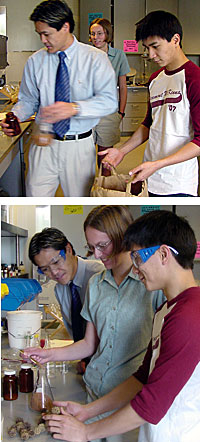 A common source of childhood artillerymaybebut a marvel of modern science?
A common source of childhood artillerymaybebut a marvel of modern science?
With help from Joint Science students Michael Fujinaka '07 and Margaret Scheuermann '08 (SCR), associate professor of chemistry Thomas Poon is unleashing a new use for sweetgum balls, those round brown, spiked droppings of the Liquidambar tree that litter lawns across the states. It seems the contents of these medieval-shaped seedpods contain shikimic acid, a key ingredient for the production of Tamiflu, a drug used to battle influenza viruses, including avian bird flu.
Until now, the starring source of shikimic acid has been star anise, a white, flowery plant used as a spice and common cough suppressant. Roche Pharmaceuticals has been extracting the compound from star anise to manufacture Tamiflu, an oral antiviral medicine that has been effective in the treatment and prevention of influenza in adults and children ages 1 and older.
While studying abroad last semester in Hong Kong, Fujinaka read an article about a shortage of Tamiflu due to a dwindling supply of shikimic acid. He then alerted Poon, knowing the chemistry professor had done work extracting shikimic acid from sweetgum treesthe common name for Liquidambarsin his previous position at another institution.
Not only are the trees abundant in the United States, they are especially plentiful in the town of Claremont, where Poon and students have conveniently plucked the seedpods from campus varieties. Using a method called natural product isolation, Poon and students mix collected seeds with methanola simple alcoholand heat the solution, which extracts out the shikimc acid. The resulting crude product is then subjected to a purification technique, obtaining a yield of about 1.5 percent shikimic acid from raw seed, in comparison to Roche's star anise yield of about 4 percent.
Although at about one-fourth Roche's extraction rate for shikimic acid, Poon says the obvious, bigger-picture benefit is the abundance and availability of sweetgum seedpods in North America. A function of the research has thus been focused on developing the best methods for extracting the compound.
News of Poon's work is spreading. The chemist traveled with CMCers last month to Atlanta to present their findings at the 231st American Chemical Society National Meeting & Exposition. By the fifth and final day of the exposition, Poon's research made the pages of the March 30 issue of The Atlanta Journal-Constitution.
Poon, who received his doctorate in organic chemistry from the University of California, Los Angeles, says that this new source of shikimic acid represents an opportunity for others who may wish to acquire the compound or to produce or sell shikimic acid to other companies or researchers. Tamiflu is not the only use for shikimic acid. More than 350 publications have appeared since 2000 describing research in which shikimic acid is used or made, he says.
"Clearly, the scientific community sees the potential for putting this chemical to use for other applications," says Poon. "In fact, one of our current research projects, which student Mike Fujinaka is also a part of, involves using shikimic acid to improve the delivery of drugs in the body."
Poon has been on the faculty of the Joint Science Department for Claremont McKenna, Pitzer, and Scripps colleges since 2000. He has broadly categorized his research interests as the "investigation of reactivity and selectivity in organic chemistry."
---By Alicia Hill '08
Science Unlocks Value of Sweetgum Seeds
Topics
Contact
Office of Strategic Communications & Marketing
400 N. Claremont Blvd.
Claremont, CA 91711
Phone: (909) 621-8099
Email: [email protected]
Media inquiries: CMC Media
Email: [email protected]
